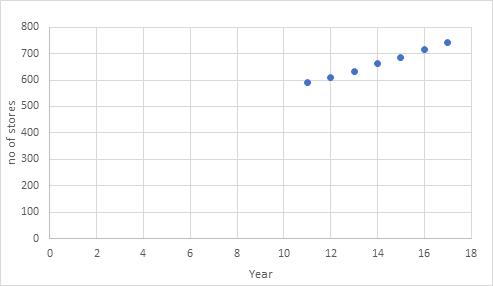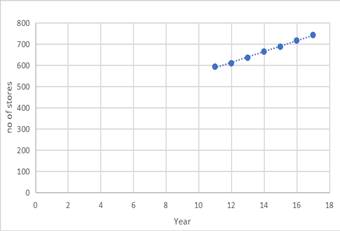
Concept explainers
(a)
To graph: the data given in the table.
(a)
Explanation of Solution
Given data:
Table of year v/s Number of stores.
Graph:
Graph for the given table:

Conclusion:
It is a increasing graph.
(b)
Linear regression of graph.
(b)
Answer to Problem 24E
Linear regression of model is
Explanation of Solution
Given data:
Table of year v/s Number of stores.
Formula used:
Slope intercept form:
Calculation:
Linear regression of the model:
Conclusion:
Linear regression of model is
(c)
To find: Table of linear model values and original values.
(c)
Explanation of Solution
Given data:
Table of year v/s Number of stores.
Formula used:
Slope intercept form:
Calculation:
Table of model values and original values:
| Year | Original values | Model values | Difference |
| 2011 | 592 | 592 | 0 |
| 2012 | 608 | 617 | 9 |
| 2013 | 634 | 642 | 8 |
| 2014 | 663 | 666 | 3 |
| 2015 | 686 | 691 | 5 |
| 2016 | 715 | 716 | 1 |
| 2017 | 741 | 741 | 0 |
(d)
To find: whether the regression model a good fir or not
(d)
Answer to Problem 24E
Yes it is a good fit.
Explanation of Solution
Given data:
Table of year v/s Number of stores.
Formula used:
Slope intercept form:
Calculation:
Yes this is a good fit because line of fit is having value nearly to all original values.

Conclusion:
Yes it is a good fit.
(e)
Number of stores for 2021
(e)
Answer to Problem 24E
Number of stores for 2021 will be 840 stores.
Explanation of Solution
Given data:
Table of year v/s Number of stores.
Formula used:
Slope intercept form:
Calculation:
Number of stores for 2021 will be:
It is a reasonable answer because as the graph is increasing with year.
Conclusion:
Number of stores for 2021 will be 840 stores.
Chapter 1 Solutions
EP PRECALC.GRAPHING APPR.-WEBASSIGN-1YR
- Use the information to find and compare Ay and dy. (Round your answers to four decimal places.) Function x-Value Differential of x Ду = dy = y = x² + 2 x = -4 Ax = dx = 0.01arrow_forwardCalculus lll May I please have the statements with blank lines completed; furthermore, may I please have the text box completed? Thank youarrow_forwardCalculus lll May I please have the statements completed for the following text lines and box? Thank you so much,arrow_forward
- Calculus lll May I please have the solution for the following exercise? Thank you so mucharrow_forwardCalculus lll May I please have the solution for the following exercise? Thank you so much,arrow_forwardCalculus lll May I please have the solution for the following exercise? Thank you so mucharrow_forward
- Calculus lll May I please have the solution for the following example? Thank youarrow_forwardCalculus lll May I please have the statement completed for the following box? Thank you so much,arrow_forwardCalculus lll May I please have the solution for the following exercise? Thank you so mucharrow_forward
- Use a graphing calculator to find where the curves intersect and to find the area between the curves. y=ex, y=-x²-4x a. The left point of intersection is (Type integers or decimals rounded to the nearest thousandth as needed. Type an ordered pair.)arrow_forwardFind the area between the curves. x= -5, x=3, y=2x² +9, y=0 The area between the curves is (Round to the nearest whole number as needed.)arrow_forwardcan you solve these questions with step by step with clear explaination pleasearrow_forward
 Calculus: Early TranscendentalsCalculusISBN:9781285741550Author:James StewartPublisher:Cengage Learning
Calculus: Early TranscendentalsCalculusISBN:9781285741550Author:James StewartPublisher:Cengage Learning Thomas' Calculus (14th Edition)CalculusISBN:9780134438986Author:Joel R. Hass, Christopher E. Heil, Maurice D. WeirPublisher:PEARSON
Thomas' Calculus (14th Edition)CalculusISBN:9780134438986Author:Joel R. Hass, Christopher E. Heil, Maurice D. WeirPublisher:PEARSON Calculus: Early Transcendentals (3rd Edition)CalculusISBN:9780134763644Author:William L. Briggs, Lyle Cochran, Bernard Gillett, Eric SchulzPublisher:PEARSON
Calculus: Early Transcendentals (3rd Edition)CalculusISBN:9780134763644Author:William L. Briggs, Lyle Cochran, Bernard Gillett, Eric SchulzPublisher:PEARSON Calculus: Early TranscendentalsCalculusISBN:9781319050740Author:Jon Rogawski, Colin Adams, Robert FranzosaPublisher:W. H. Freeman
Calculus: Early TranscendentalsCalculusISBN:9781319050740Author:Jon Rogawski, Colin Adams, Robert FranzosaPublisher:W. H. Freeman
 Calculus: Early Transcendental FunctionsCalculusISBN:9781337552516Author:Ron Larson, Bruce H. EdwardsPublisher:Cengage Learning
Calculus: Early Transcendental FunctionsCalculusISBN:9781337552516Author:Ron Larson, Bruce H. EdwardsPublisher:Cengage Learning





